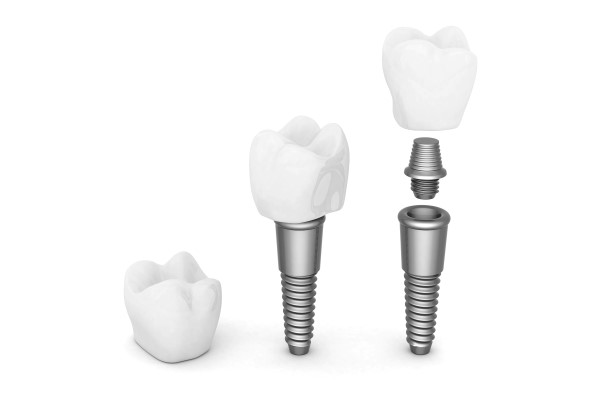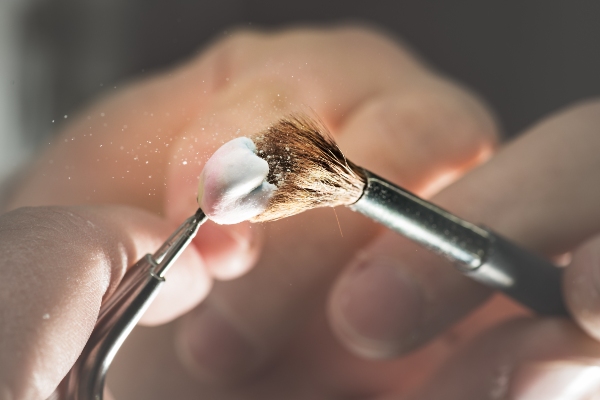Dental Implant Restoration -How Is a Dental Crown Attached to an Implant?

A dental crown replaces the missing tooth when it is attached as a dental implant restoration. With the tooth implant embedded in the jaw and the crown lying above the gum line, it is easy to wonder how the components connect. Crowns connect to dental implants with two main mechanisms, both of which will be discussed in this article.
Components of the dental implant restoration
The dental implant restoration is made up of three parts, including the dental implant which sits inside the jaw, the abutment (which connects the implant and the crown) and the crown or artificial tooth. The crown is the upper visible part of the dental implant restoration and it attaches to the implant through the abutment. It can be connected with screws or dental cement. Each option has its application, advantages and drawbacks.
Connecting a dental crown using oral cement
The dental professional can opt to connect the crown to the abutment using dental cement. It is often used for front-row teeth for cosmetic reasons. The dental cement used is tooth-colored, meaning that the front-facing dental crown will not experience the discoloration that sometimes occurs with screw-retained crowns. However, there are some downsides to using this technique.
A dental restoration attached using cement is expected to stay permanent on the jaw and not to be removed. However, for some reason, the implant crown may need to be repaired or replaced eventually. The adjustment would certainly require removing the crown, which would be significantly difficult because it was cemented to the implant. Removing the crown is challenging and will almost certainly require breaking it, which typically results in a need for replacement.
Screw-retained dental crowns
It is also possible to attach a dental crown by screwing it directly to the abutment. Considering factors such as longevity, ease of repair and the ease of application, connecting the dental crown with a screw is the preferred option to consider. The major drawback of using screws is that they are not as cosmetically-appealing as dental cement, which is the reason they are often used for the back teeth.
Some of the benefits of attaching a dental crown with screws include:
- It is safer to use screws for connecting same-day, implant-supported crowns
- It is easier to remove screw-retained crowns for repairs or replacement
- If a nearby tooth falls out, the screwed crown can be replaced with one that can support a dental bridge
Temporary dental crowns are used to get the gum tissue ready for the permanent crown. These crowns are retained using screws and are easy to remove when it is time to place the final crown.
In summary
The option that the dentist chooses for connecting the dental crown to a dental implant will depend on the patient’s unique case and preferences. The general dentist will walk each patient through the options and explain the advantages and downsides of each option. To learn more about dental implant restorations, contact the dental office to book an appointment.
Request an appointment here: https://www.mysaratogadentist.com or call My Saratoga Dentist PLLC at (518) 675-3094 for an appointment in our Saratoga Springs office.
Check out what others are saying about our dental services on Yelp: Dental Implant Restoration in Saratoga Springs, NY.
Recent Posts
Aftercare and long-term care are vital for maintaining the results if you have recently undergone a dental restoration procedure. Maintaining the results does not have to be difficult; however, you must remain dedicated to caring for your new smile. Following the simple tips below will extend the life of your new dental work.No matter the…
Seeing your dentist for a dental restoration can be nerve-racking if you do not know what to expect. Some procedures are invasive, while others are not. Knowing more about the different processes can help you make informed decisions about your procedure. Here are five dental restoration FAQs you can ask your dentist.This dental restoration refers…
Getting the right dental restoration can improve your appearance and dental health. Your dentist will discuss the possible procedures that will fit your needs. Knowing more about these treatments can help you prepare for your next visit. Here are the common dental restoration procedures available.These restorations can be tooth-colored porcelain, gold, or composite material. This…
There appears to be some overlap between dental restorations and cosmetic dentistry. However, people need to know the difference between the two because dental insurance may cover a dental restoration but not a cosmetic procedure. This article examines the key differences between the two types of dentistry and provides examples of each.The primary difference between…


